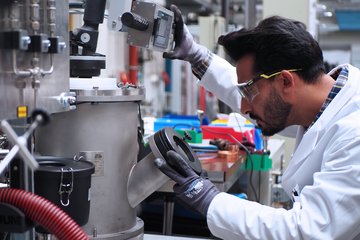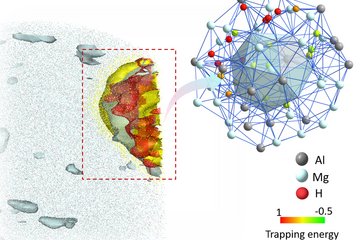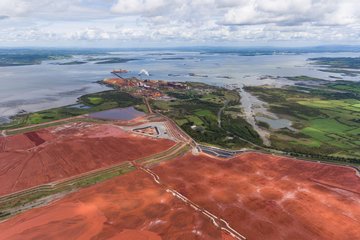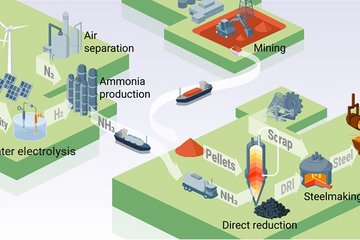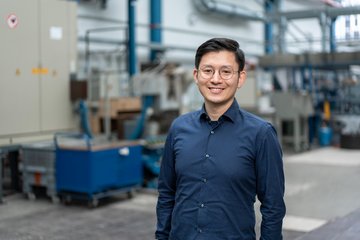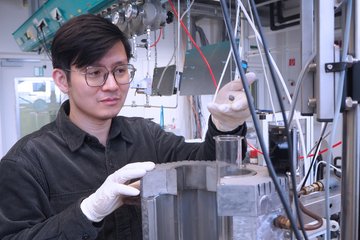Alle Typen
21.
Zeitschriftenartikel
Effects of heat treatment on near surface elemental profiles of Fe–15Cr polycrystalline alloy. Corrosion Engineering, Science and Technology 40 (3), S. 217 - 225 (2005)
22.
Zeitschriftenartikel
Early stages of protective layer growth on binary iron aluminides. Zeitschrift für physikalische Chemie 219, S. 1489 - 1503 (2005)
23.
Zeitschriftenartikel
B and N segregation on dual phase steel after annealing. Defect and Diffusion Forum 237 – 240, S. 934 - 934 (2005)
24.
Zeitschriftenartikel
Selective Oxidation and Surface Segregation in High Strength Steels during short term annealing in N2-H2 -Influence of B an surface chemistry. Steel Research Int. 76 (11), S. 832 - 832 (2005)
25.
Zeitschriftenartikel
Initial oxidation of Fe–Cr alloys: In situ STM and ex-situ SEM observations. Materials at High Temperatures 22 (3-4), S. 567 - 573 (2005)
26.
Zeitschriftenartikel
Initial oxidation of Fe–Cr alloys: In situ STM and ex situ SEM observation. Materials at High Temperatures 22 (3-4), S. 567 - 573 (2005)
27.
Zeitschriftenartikel
Annealing of Fe–15Cr alloy in N2–5%H2 gas mixture: Effect of hydrogen concentration. Defect and Diffusion Forum 237-240, S. 928 - 928 (2005)
28.
Zeitschriftenartikel
Evolution of near-surface concentration profiles of Cr during annealing of Fe–15Cr polycrystalline alloy. Applied Surface Science 249 (1-4), S. 127 - 138 (2005)
29.
Zeitschriftenartikel
In-situ FE-SEM and EBSD Investigation on the Oxidation of Pure Iron. Mater. at High Temp. Proc. of Microscopy of Oxidation, S. 9 - 18 (2005)
30.
Zeitschriftenartikel
Internal Oxidation of Fe–Al alloys in KCl-air atmosphere at 650°C. Oxidation of Metals 61 (3-4), S. 303 - 322 (2004)
31.
Zeitschriftenartikel
Fundamental studies on alkali chloride induced corrosion during combustion of biomass. Materials Science Forum 461–464, S. 1055 - 1055 (2004)
32.
Zeitschriftenartikel
Role of Alloying Elements and Carbides in the Chlorine-induced Corrosion of Steels and Alloys. Materials Research 7 (1), S. 89 - 95 (2004)
33.
Zeitschriftenartikel
Models describing the degradation of FeAl and NiAl alloys induced by ZnCl2/KCl melt at 400-450 °C. Corrosion Science 46, 8 (2004)
34.
Zeitschriftenartikel
High temperature interactions of pure Cr with KCl. Materials Science Forum 461-464, S. 1047 - 1054 (2004)
35.
Zeitschriftenartikel
Surface modification of various Fe-Si and Fe-Mn alloys by oxidation/reduction treatments. Surface Engineering 20, 2 (2004)
36.
Zeitschriftenartikel
Development of spinel forming alloys with improved electronic conductivity for MCFC application. Journal of Power Sources 135, S. 52 - 61 (2004)
37.
Zeitschriftenartikel
Initial stages of Al203 growth on Fe–Al intermetallic phases. Lithos 73, 1-2, S. S89 - S89 (2004)
38.
Zeitschriftenartikel
Kinetic investigations on salt melt induced high temperature corrosion of pure metals. Materials Science Forum 461-464, S. 61 - 68 (2004)
39.
Zeitschriftenartikel
Occurrence of Metal Dusting - Referring to Failure Cases. Material and Corrosion 54 (10), S. 799 - 804 (2003)
40.
Zeitschriftenartikel
The Role of Molten Salts in the Corrosion of metals in Waste Incineration Plants. Molten Salt Forum 7, S. 253 - 268 (2003)
